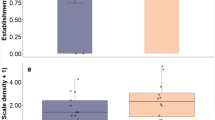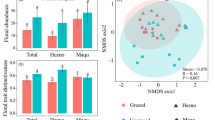Abstract
Improving our knowledge of regeneration processes in riparian woodlands could help guide restoration projects by enhancing the natural regeneration potential of riparian tree species. In western Europe, Populus nigra, is a major component of riparian woodlands, but the spatial extent of this species has decreased due to river management activities. In this study, the timing of Populus nigra seed dispersal and variations in seed germinability through time were monitored. An experiment was also devised to measure both seed germination and seedling survival in changing bydrologic conditions. The seed dispersal period lasted 12 weeks along the Garonne River. Individual poplar trees displayed variations in seed release patterns. On average, seed germinability remained rather low and close to 28%. However, large differences in germinability were observed between trees and over time. A continuously wet substrate was the most favorable condition for germination and seedling survival. A change from wet to submerged conditions increased germination and reduced seedling survival. In the case of a change from either wet or submerged to dry conditions, there was no survival possible if the dry conditions persisted more than one week. Substrate type had a significant effect on germinability only in moderate moisture conditions. Populus nigra tolerates decreases in the optimum minimum flow if coupled with at least a brief rise in river level on a weekly basis.
Similar content being viewed by others
Literature cited
Barsoum, N. 1998. A comparison of vegetative and non-vegetative regeneration strategies in Populus nigra and Salix alba. Ph.D. Dissertation. University of Cambridge, Cambridge, UK.
Barsoum, N. and F. M. R. Hughes. 1998. Regeneration response of black poplar to changing river levels. p. 397–412. In W. H. Wheater, C. Kirkby, R. Harding, and D. Gilvear (eds). Hydrological Society and Wiley’s, Chichester, UK.
Bessey, D. E. 1904. The number and weight of cottonwood seeds. Science 20:118–119.
Bradley, E. B. and D. G. Smith 1986. Plains cottonwood recruitment and survival on a prairie meandering river floodplain, Milk River, southern Alberta and northern Montana. Canadian Journal of Botany 64:1433–1442.
Braatne, J. H., S. B. Rood, and P. E. Heilman. 1996. Life history, ecology and conservation of riparian cottonwoods in North America. p. 57–85. In R. F. Stettler, H. D. Bradshaw, P. E. Heilman, and T. M. Hinckley (eds.) Biology of Populus and Its Implications for Management and Conservation. NRC Research Press, Ottawa, ON, Canada.
Briggs, M. K. and S. Cornelius. 1998. Opportunities for ecological improvement along the lower Colorado River and Delta. Wetlands 18:513–529.
Busch, D. E. and S. D. Smith. 1995. Mechanism associated with decline of woody species in riparian ecosystems of the south-western U.S. Ecological Monographs 65:347–370.
Cagelli, L. and F. Lefevre. 1996. The conservation of Populus nigra and gene flow with cultivated poplars in Europe. Forest Genetics 2:135–144.
Cooper D. J., D. M. Merrit, D. C. Andersen, and R. A. Chimner. 1999. Factors controlling the establishment of Fremont Cottonwood seedlings on the Upper Green River, USA. Regulated Rivers: Research and Management 15:419–440.
Engstrom, A. 1948. Growing cottonwood from seeds. Journal of Forestry 46:130–132.
Farmer R. E. and F. T. Bonner. 1967. Germination and initial growth of eastern cottonwood as influenced by moisture stress, temperature and storage. Botanical Gazette 128:211–215.
Fenner P., W. W. Brady, and D. R. Patton. 1984. Observations on seeds and seedlings of Fremont Cottonwood. Desert Plants 6:55–58.
Foussadier, R. 1998. Initiation des successions végétales dans les lits endigués des cours d’eau alpins. Influence des paramètres abiotiques sur la régénération des Salicacées. Ph. D. Dissertation. University of Grenoble, Grenoble, France.
Friedman J. M., M. L. Scott, and W. M. Lewis. 1995. Restoration of riparian forest using irrigation, artificial disturbance and natural seedfall. Environmental Management 19:547–557.
Frison, E., F. Lefèvre, S. De Vries, and J. Turok. 1994. European Forest Genetic resources programme. Populus nigra Network. Report of the first meeting. 3–5 October 1994. Izmit, Turkey.
Gladwin, D. N. and J. E. Roelle. 1998. Survival of plains cottonwood (Populus deltoïdes subsp. monilifera) and saltcedar (Tamarix ramossssima) seedlings in response to flooding. Wetlands 18:669–674.
Hardin E. D. 1984. Variation in seed weight, number of seed per capsule and germination in Populus deltoides Bartr. trees in Southern-Eastern Ohio. American Midland Naturalist 112:29–34.
Harrington, C. A.. 1987. Responses of red alder and black cottonwood seedlings to flooding. Physiologia Plantarum 69:35–48.
Johnson R. L.. 1965. Regenerating cottonwoods from natural seedfall. Journal of Forestry 63:33–36.
Johnson W. C.. 1994. Woodland expansion in the Platte River, Nebraska: patterns and causes. Ecological Monographs 64:45–84.
Kozlowski T. T.. 1982. Water supply and tree Growth. Part II: flooding. Forest Abstracts 43:145–161.
Laquerbe, M.. 1997. Dynamique du paysage riverain des bords de la Garonne: effets anthropiques. Bulletin de la Société d’Histoire Naturelle de Toulouse 133:7–13.
Large A. R. G. and G. E. Petts. 1996 Rehabilitation of River Margins. p. 106–123. In G. E. Petts and C. Callow (eds.) River Restoration. Blackwell Science Ltd, Oxford, UK.
Larsen P.. 1996. Restoration of river corridors: German experiences. p. 124–143. In G. E. Petts and C. Callow (eds.) River Restoration. Blackwell Science Ltd, Oxford, UK.
Lee, C., J. M. Mahoney, and S. B. Rood. 1991. Poplar seeds and seedlings along the St Mary, Belly and Waterton Rivers, Alberta. p. 85–90. In S. B. Rood and J. M. Mahoney (eds.) The Biology and Management of Southern Alberta’s Cottonwoods. Proceedings of the University of Lethbridge Conference, May 4–6 1990, Lethbridge, AB, Canada.
Lefève, F., A. Legionnet, S. De Vries, and J. Turok. 1998. Strategies for the conservation of a pionner tree species, Populus nigra L., in Europe. Genetic Selection Evolution(Suppl. 1):S181–196.
Legionnet, A.. 1996. Diversité et fonctionnement génétique des populations naturelles de Populus nigra L., espèce des ripisylves européennes. Ph.D. Dissertation. University of Montpellier II, Montpellier, France.
Legronnet, A., P. Faivre-Rampant, M. Villar, and F. Lefèvre. 1997. Sexual and asexual reproduction in natural stands of Populus nigra. Botanica Acta 110:257–263.
Mahoney, J. M. and S. B. Rood. 1998. Streamflow requirements for cottonwood seedling recruitment —an integrative model: Wetlands 18:634–645.
Mahoney, J. M. and S. B. Rood. 1991. A device for studying the influence of declining water table on poplar growth and survival. Tree Physiology 8:305–314.
Mahoney, J. M. and S. B. Rood. 1992. Response of a hybrid poplar to water table decline in different substrates. Forest Ecology and Management 54:141–156.
Mc Bride, J. R. and J. Strahan. 1984. Establishment and survival of woody riparian species on gravel bars on an intermittent stream. The American Midland Naturalist 112:235–245.
Merigliano, M. F.. 1998. Cottonwood and willow demography on a young island, Salmon River, Idaho. Wetlands 18:571–576.
Muller, C. and E. Teissier du Cros. 1982. Conservation pendant 5 ans de graines de peupliers noirs (Populus nigra L.). Anales de Sciences Forestières 39:179–185.
Moss, E. H.. 1938. Longevity of seed and establishment of seedlings in species of Populus. Botanical Gazette 99:529–542.
Noble, M. G.. 1979. The origin of Populus deltoïdes and Salix interior zones on point bars along the Minnesota River. The American Midland Naturalist 102:59–67.
Reily, P. W. and W. C. Johnson. 1982. The effects of altered hydrologic regime on tree growth along the Missouri River in North Dakota. Canadian Journal of Botany 60:2410–2423.
Rood S. B. and s. Heinz-Milne. 1989. Abrupt downstream forest decline following river damming in southern Alberta. Canadian Journal of Botany 67:1744–1749.
Rood, S. B., J. M. Mahoney, D. E. Reid, and L. Zilm. 1995. Instream flows and the decline of riparian cottonwoods along the St Mary River, Alberta. Canadian Journal of Botany 73:1250–1260.
Rood, S. B., A. R. Kalischuk, and J. M. Mahoney. 1998. Initial cottonwood seedling recruitment following the flood of the century of the oldman River, Alberta, Canada. Wetlands 18:557–570.
Rood, S. B., K. Taboulchanas, C. E. Bradley, and A. R. Kalischuk. 1999. Influence of flow regulation on channel dynamicss and riparian cottowoods along the Bow River, Alberta. Rivers 7:33–48.
Sacchi, C. F. and P. W. Price. 1992. The relative roles of abiotic and biotic factors in seedling demography of Arroyo Willow (Salix lasiolepis: Salicaceae). American Journal of Botany 79:395–405.
Schreiner, E. J. 1974. Populus L. Poplar p.645–655. In C. S. Schopmeyer (ed.) Seeds of Woody Plants in the United States. Handbook 450. U.S. Department of Agriculture, Washington, DC, USA.
Segelquist, C. A., M. L. Scott, and G. P. Auble. 1993. establishment of Populus deltoides under simulated alluvial groundwater declines. American Midland Naturalist 130:274–285.
Shafroth P. B., G. T. Auble, J. C. Stromberg, and D. T. Patten. 1998. Establishment of woody riparian vegetation in relation to annual pattern of streamflow, Bill Williams river, Arizona. Wetlands 18:577–590.
Stromberg J. C., D. T. Patten, and B. D. Richter. 1991. Flood flows and dynamics of Sonorian riparian forests. Rivers 2:221–235.
Tabbush, P. 1998. Genetic conservation of Black Poplar (Populus nigra L.). Watsonia 22:173–179.
Van Splunder, I., H. Coops, L. A. C. J. Voesenek, and C. W. P. M. Blom. 1995. Establishment of alluvial forest species in flood-plains: the role of dispersal timing, germination characteristics and water level fluctuations. Acta Botanica Neerlandica 44:269–278.
Van Splunder, I., L. A. C. J. Voesenek, H. Coops, X. J. A. De Vries, and C. W. P. M. Blom. 1996. Morphological responses of seedlings of four species of Salicaceae to drought. Canadian Journal of Botany 74:1988–1995.
Virginillo, M., J. M Mahoney, and S. B. Rood. 1991. Establishment and survival of poplar seedlings along the Oldman River, Southern Albertap. p. 55–61. In S. B. Rood and J. M. Mahoney (eds.) The Biology and Management of Southern Alberta’s Cottonwoods. Proceedings of the University of Lethbridge Conference, May 4–6 1990, Lethbridge, A.B, Canada.
Walker, L. R., J. C. Zasada, and F. S. Chapin, 1986. The role of history processes in primary succession on an alaskan floodplain. Ecology 67:1243–1253.
Author information
Authors and Affiliations
Rights and permissions
About this article
Cite this article
Guilloy-Froget, H., Muller, E., Barsoum, N. et al. Dispersal, germination, and survival of Populus nigra L. (Salicaceae) in changing hydrologic conditions. Wetlands 22, 478–488 (2002). https://doi.org/10.1672/0277-5212(2002)022[0478:DGASOP]2.0.CO;2
Received:
Revised:
Accepted:
Issue Date:
DOI: https://doi.org/10.1672/0277-5212(2002)022[0478:DGASOP]2.0.CO;2




